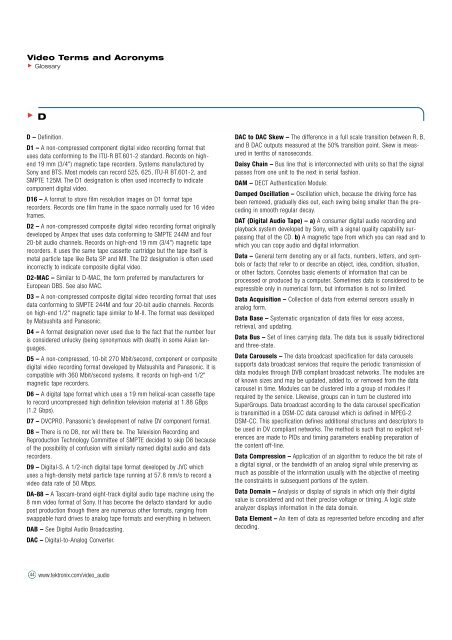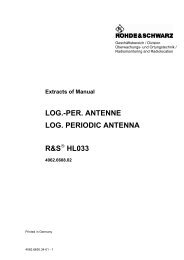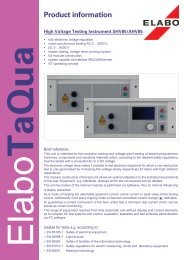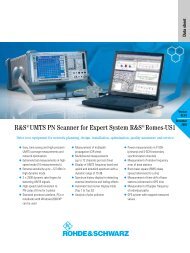Glossary of Video Terms and Acronyms - Isotest
Glossary of Video Terms and Acronyms - Isotest
Glossary of Video Terms and Acronyms - Isotest
Create successful ePaper yourself
Turn your PDF publications into a flip-book with our unique Google optimized e-Paper software.
<strong>Video</strong> <strong>Terms</strong> <strong>and</strong> <strong>Acronyms</strong><br />
<strong>Glossary</strong><br />
D<br />
D – Definition.<br />
D1 – A non-compressed component digital video recording format that<br />
uses data conforming to the ITU-R BT.601-2 st<strong>and</strong>ard. Records on highend<br />
19 mm (3/4") magnetic tape recorders. Systems manufactured by<br />
Sony <strong>and</strong> BTS. Most models can record 525, 625, ITU-R BT.601-2, <strong>and</strong><br />
SMPTE 125M. The D1 designation is <strong>of</strong>ten used incorrectly to indicate<br />
component digital video.<br />
D16 – A format to store film resolution images on D1 format tape<br />
recorders. Records one film frame in the space normally used for 16 video<br />
frames.<br />
D2 – A non-compressed composite digital video recording format originally<br />
developed by Ampex that uses data conforming to SMPTE 244M <strong>and</strong> four<br />
20-bit audio channels. Records on high-end 19 mm (3/4") magnetic tape<br />
recorders. It uses the same tape cassette cartridge but the tape itself is<br />
metal particle tape like Beta SP <strong>and</strong> MII. The D2 designation is <strong>of</strong>ten used<br />
incorrectly to indicate composite digital video.<br />
D2-MAC – Similar to D-MAC, the form preferred by manufacturers for<br />
European DBS. See also MAC.<br />
D3 – A non-compressed composite digital video recording format that uses<br />
data conforming to SMPTE 244M <strong>and</strong> four 20-bit audio channels. Records<br />
on high-end 1/2" magnetic tape similar to M-II. The format was developed<br />
by Matsushita <strong>and</strong> Panasonic.<br />
D4 – A format designation never used due to the fact that the number four<br />
is considered unlucky (being synonymous with death) in some Asian languages.<br />
D5 – A non-compressed, 10-bit 270 Mbit/second, component or composite<br />
digital video recording format developed by Matsushita <strong>and</strong> Panasonic. It is<br />
compatible with 360 Mbit/second systems. It records on high-end 1/2"<br />
magnetic tape recorders.<br />
D6 – A digital tape format which uses a 19 mm helical-scan cassette tape<br />
to record uncompressed high definition television material at 1.88 GBps<br />
(1.2 Gbps).<br />
D7 – DVCPRO. Panasonic’s development <strong>of</strong> native DV component format.<br />
D8 – There is no D8, nor will there be. The Television Recording <strong>and</strong><br />
Reproduction Technology Committee <strong>of</strong> SMPTE decided to skip D8 because<br />
<strong>of</strong> the possibility <strong>of</strong> confusion with similarly named digital audio <strong>and</strong> data<br />
recorders.<br />
D9 – Digital-S. A 1/2-inch digital tape format developed by JVC which<br />
uses a high-density metal particle tape running at 57.8 mm/s to record a<br />
video data rate <strong>of</strong> 50 Mbps.<br />
DA-88 – A Tascam-br<strong>and</strong> eight-track digital audio tape machine using the<br />
8 mm video format <strong>of</strong> Sony. It has become the defacto st<strong>and</strong>ard for audio<br />
post production though there are numerous other formats, ranging from<br />
swappable hard drives to analog tape formats <strong>and</strong> everything in between.<br />
DAB – See Digital Audio Broadcasting.<br />
DAC – Digital-to-Analog Converter.<br />
44 www.tektronix.com/video_audio<br />
DAC to DAC Skew – The difference in a full scale transition between R, B,<br />
<strong>and</strong> B DAC outputs measured at the 50% transition point. Skew is measured<br />
in tenths <strong>of</strong> nanoseconds.<br />
Daisy Chain – Bus line that is interconnected with units so that the signal<br />
passes from one unit to the next in serial fashion.<br />
DAM – DECT Authentication Module.<br />
Damped Oscillation – Oscillation which, because the driving force has<br />
been removed, gradually dies out, each swing being smaller than the preceding<br />
in smooth regular decay.<br />
DAT (Digital Audio Tape) – a) A consumer digital audio recording <strong>and</strong><br />
playback system developed by Sony, with a signal quality capability surpassing<br />
that <strong>of</strong> the CD. b) A magnetic tape from which you can read <strong>and</strong> to<br />
which you can copy audio <strong>and</strong> digital information.<br />
Data – General term denoting any or all facts, numbers, letters, <strong>and</strong> symbols<br />
or facts that refer to or describe an object, idea, condition, situation,<br />
or other factors. Connotes basic elements <strong>of</strong> information that can be<br />
processed or produced by a computer. Sometimes data is considered to be<br />
expressible only in numerical form, but information is not so limited.<br />
Data Acquisition – Collection <strong>of</strong> data from external sensors usually in<br />
analog form.<br />
Data Base – Systematic organization <strong>of</strong> data files for easy access,<br />
retrieval, <strong>and</strong> updating.<br />
Data Bus – Set <strong>of</strong> lines carrying data. The data bus is usually bidirectional<br />
<strong>and</strong> three-state.<br />
Data Carousels – The data broadcast specification for data carousels<br />
supports data broadcast services that require the periodic transmission <strong>of</strong><br />
data modules through DVB compliant broadcast networks. The modules are<br />
<strong>of</strong> known sizes <strong>and</strong> may be updated, added to, or removed from the data<br />
carousel in time. Modules can be clustered into a group <strong>of</strong> modules if<br />
required by the service. Likewise, groups can in turn be clustered into<br />
SuperGroups. Data broadcast according to the data carousel specification<br />
is transmitted in a DSM-CC data carousel which is defined in MPEG-2<br />
DSM-CC. This specification defines additional structures <strong>and</strong> descriptors to<br />
be used in DV compliant networks. The method is such that no explicit references<br />
are made to PIDs <strong>and</strong> timing parameters enabling preparation <strong>of</strong><br />
the content <strong>of</strong>f-line.<br />
Data Compression – Application <strong>of</strong> an algorithm to reduce the bit rate <strong>of</strong><br />
a digital signal, or the b<strong>and</strong>width <strong>of</strong> an analog signal while preserving as<br />
much as possible <strong>of</strong> the information usually with the objective <strong>of</strong> meeting<br />
the constraints in subsequent portions <strong>of</strong> the system.<br />
Data Domain – Analysis or display <strong>of</strong> signals in which only their digital<br />
value is considered <strong>and</strong> not their precise voltage or timing. A logic state<br />
analyzer displays information in the data domain.<br />
Data Element – An item <strong>of</strong> data as represented before encoding <strong>and</strong> after<br />
decoding.





